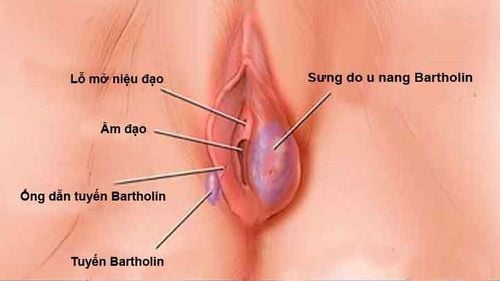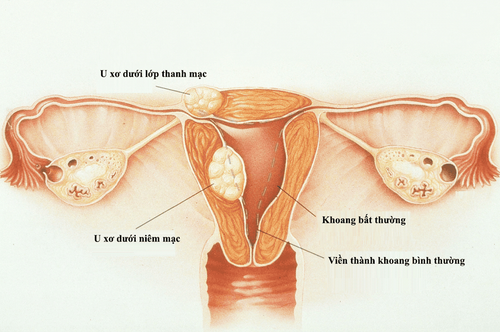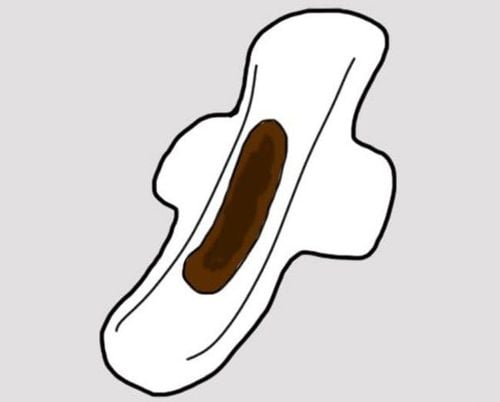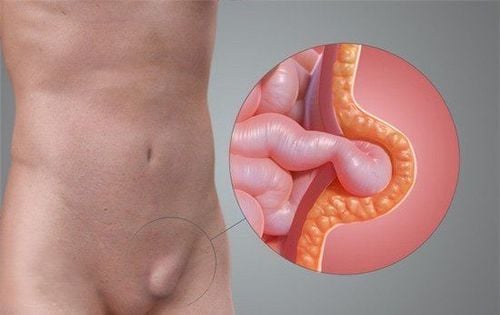This is an automatically translated article.
The article is expertly consulted by Master, Doctor Le Nhat Nguyen - Obstetrician-Gynecology Specialist - Vinmec Danang International General Hospital.Uterine fibroids are a very common disease in women of childbearing age, especially those with high oestrogen, who did not give birth or gave birth late. Uterine fibroids are a benign disease that, if detected early, can be cured very easily. Uterine fibroid surgery is one of the modern treatment methods to quickly improve the disease, including open surgery.
1. What are uterine fibroids?
A fibroid is a benign (non-cancerous) growth that develops from the muscle tissue of the uterus, also known as a leiomyoma or myoma. The size, shape, and location of fibroids vary widely. They can appear internally, on the outer surface, in the wall of the uterus, or they are attached to the outside of the uterus with a tree-like structure. A woman can have only one fibroid or multiple fibroids of different sizes. Fibroids can be very small for a long time then suddenly increase rapidly or increase slowly over many years.2. Who is at risk for uterine fibroids?
Uterine fibroids can be found at any age, but are most common in women between the ages of 30 and 40. Nation. Black women are more likely to have fibroids than women of other racial groups. Additionally, black women get fibroids at a younger age, and they're also more likely to have a greater number of fibroids, or larger, more severe symptoms. Genetic. If the mother or sister has fibroids, the sister has a higher risk of developing the disease than other subjects. Other factors. Menstrual symptoms from an early age; fat; vitamin D deficiency; have a diet high in red meat and low in green vegetables, fruits and dairy products; Drinking alcohol is likely to increase the risk of developing uterine fibroids.
Người béo phì có nguy cơ mắc u xơ tử cung
3. What are the symptoms of uterine fibroids?
Many women with fibroids do not have any symptoms. In people who do, symptoms can be influenced by the location, size, and number of fibroids.In women with symptomatic fibroids, the most common signs and symptoms of uterine fibroids include:
Heavy menstrual bleeding Menstrual cycles lasting more than a week Pelvic pain or Abdominal frequent urination Difficulty emptying the bladder Constipation Back or leg pain Rarely, a fibroid can cause acute pain when it exceeds its blood supply and begins to die. Usually classified by location:
Subserosal fibroids Fibroids in the myometrium Submucosal fibroids Submucosal fibroids can be in the cervix or in the broad ligament
4. If fibroids are not treated, how dangerous will it be?
Although fibroids are not usually dangerous, they can be uncomfortable and can lead to complications such as low red blood cells (anemia), fatigue, and heavy blood loss.Fibroids usually do not affect pregnancy. However, it is possible that uterine fibroids - especially submucosal fibroids - can cause infertility or miscarriage. Fibroids can also increase the risk of certain pregnancy complications, such as placental abruption, fetal growth restriction, and premature birth.

U xơ thường không ảnh hưởng đến việc mang thai
5. Method of open surgery to remove uterine fibroids
For uncomplicated small tumors, only regular follow-up every 3 months. Surgical treatment is considered as a radical treatment, especially in the following cases:When uterine fibroids are as big as a uterus of about 12 weeks pregnant. When there are symptoms of ureteral compression, causing hydronephrosis. When there are complications of menorrhagia, heavy bleeding, or prolonged hypermenorrhoea, failure of internal therapy or submucosal fibroids. When the tumor is in the broad ligament. When cancer is suspected.
In cases where surgery is not possible, medical treatment can be applied, but only for symptomatic treatment, completely without atrophy of the fibroid.
Mainly treatment with progesterone for cases of tumors with menstrual disorders: Menorrhagia, heavy bleeding that cannot be operated on immediately, indicated for patients who are too young to have children or have medical conditions. Medical management increases the risk of surgery.
When is the indication for open surgery to remove uterine fibroids?
Currently, laparoscopic fibroid surgery is a popular treatment method and is used more because of its low cost, less pain, high aesthetics and quick recovery. faster. Except for cases of large uterine fibroids, there is a possibility of complications such as torsion, tumor rupture, ... the doctor will proceed to cut the tumor through a large incision in the abdomen. The tumor will be biopsied immediately and if it is benign, the doctor may perform a fibroid removal.
For this surgery, the doctor will make a single long incision in the abdomen, ideally at the bikini line, to access the tumor and treat it. Open surgery makes it easier for the surgeon to see the pelvic organs that are difficult to see in cases with large uterine fibroids or tumors located in difficult to reach locations. The disadvantages of open surgery are the risks of general anesthesia, blood loss, pain, and infection. The recovery time of open surgery is also longer, the patient must stay in the hospital for at least 3-4 days and it takes about 4-6 weeks to return to normal activities.
6. Why should you choose surgery for uterine fibroids at Vinmec hospital?

Tại bệnh viện đa khoa Vinmec đã triển khai phương pháp phẫu thuật bóc nhân xơ tử cung bằng robot được đánh giá là phương pháp ưu việt hàng đầu hiện nay với u xơ tử cung
Vision is not restricted compared to traditional surgery and gives images with higher accuracy, more optimal image quality. Using a surgical robot will help limit and eliminate unnecessary vibrations because the robot has 4 hands, equivalent to 2 surgeons. The robot has the ability to operate in difficult positions because it can move freely at 6 angles, wriggle into the deepest and smallest cavities. Robotic surgery is safe and minimizes the risk of complications, surgical infection. Compared to conventional methods, using surgical robots will help reduce pain. Hysterectomy with modern robotic surgery results in less blood loss, faster recovery and shorter hospital stay. The aesthetics of this method is higher because the surgical scar is smaller. Many patients often worry about how long they will stay in hospital after surgery for fibroids. With the advantages of robotic surgery such as less blood loss, less pain and safety, Vinmec's Enhanced Recovery After Surgery (ERAS) program also helps patients quickly recover and reduce time. hospital stay after surgery. When registering for fibroid dissection by robotic surgery in combination with Vinmec's Enhanced Recovery After Surgery (ERAS) program, the patient will be cared for 24 hours a day and monitored continuously for at least 24 hours. 2 days after surgery with advanced medical equipment, modern monitoring machines (heart rate monitor, blood pressure, pulse measurement).
In addition, to ensure the earliest possible recovery and reduce pain for the patient, the team of anesthesiologists, physiotherapists, and nutritionists always accompanies the patients. Along with that is a team of nurses who are professionally trained to perform private care and serve post-operative cases.
Doctor Le Nhat Nguyen has more than 20 years of experience in the field of Obstetrics and Gynecology. Formerly a doctor of obstetrics and gynecology at Gia Dinh People's Hospital in Ho Chi Minh City. Doctor has high expertise and strength in diagnosing and treating Obstetrics and Gynecology diseases such as:
Reproductive endocrinology Family planning Gynecological cancer Advanced laparoscopic surgery in gynecology Customers can visit Next, go to Vinmec Da Nang to visit or contact hotline 0236 3711 111 for support.














